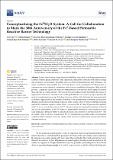Conceptualizing the Fe0/H2O System: A Call for Collaboration to Mark the 30th Anniversary of the Fe0-Based Permeable Reactive Barrier Technology

View/
Date
2022-10-03Author
Cao, Viet
Bakari, Omari
Tchidjo, Joseline
Bandjun, Nadège
Tchoupé, Arnaud
Gwenzi, Willis
Njau, Karoli
Noubactep, Chicgoua
Metadata
Show full item recordAbstract
Science denial relates to rejecting well-established views that are no longer questioned by scientists within a given community. This expression is frequently connected with climate change and evolution. In such cases, prevailing views are built on historical facts and consensus. For water remediation using metallic iron (Fe0), also known as the remediation Fe0/H2O system, a consensus on electro-chemical contaminant reduction was established during the 1990s and still prevails. Arguments against the reductive transformation concept have been regarded for more than a decade as ‘science denial’. However, is it the prevailing concept that denies the science of aqueous iron corrosion? This article retraces the path taken by our research group to question the reductive transformation concept. It is shown that the validity of the following has been questioned: (i) analytical applications of the arsenazo III method for the determination of uranium, (ii) molecular diffusion as sole relevant mass-transport process in the vicinity of the Fe0 surface in filtration systems, and (iii) the volumetric expansive nature of iron corrosion at pH > 4.5. Item (i) questions the capability of Fe0 to serve as an electron donor for UVI reduction under environmental conditions. Items (ii) and (iii) are inter-related, as the Fe0 surface is permanently shielded by a non-conductive oxide scale acting as a diffusion barrier to dissolved species and a barrier to electrons from Fe0. The net result is that no electron transfer from Fe0 to contaminants is possible under environmental conditions. This conclusion refutes the validity of the reductive transformation concept and calls for alternative theories.
